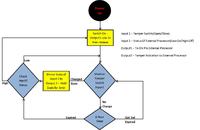speedEC
Full Member level 6
Dear All,
I need some help on saving current consumption while the PIC MCU in SLEEP mode. I used three interrupts that is INT0, RBIF and Comparator Interrupts. I have used 6v, 4.2Ah sealed lead acid battery. I have used WDT to wake up the device every 24 Hrs. Until then I put the device in SLEEP mode. After 24 Hrs expires I have to enable comparator to check the Battery Voltage and If Battery Voltage is not low again I put PIC into SLEEP mode.
I have not drawn any current from pins of PIC MCU except drive transistors (RB0 and RB4) as follows:
But, I found so much current consumed by the PIC MCU even though it is in Sleep mode.
Setting Comparator Interrupts as follows.
WDT Settings - 1:128 prescale
Disable Comparators before go in to SLEEP mode
Put PIC into SLEEP Mode:
I wake up the PIC MCU only if 24 hrs expires:
Once if battery voltage is not low again disabled the comparators and put PIC in to SLEEP.
I have to drive one transistor thro' RB4 pin (Vdd) and RB0 (Vdd) to capture IOC and INT0 interrupt respectively.
Any Help pl?
Thanks
I need some help on saving current consumption while the PIC MCU in SLEEP mode. I used three interrupts that is INT0, RBIF and Comparator Interrupts. I have used 6v, 4.2Ah sealed lead acid battery. I have used WDT to wake up the device every 24 Hrs. Until then I put the device in SLEEP mode. After 24 Hrs expires I have to enable comparator to check the Battery Voltage and If Battery Voltage is not low again I put PIC into SLEEP mode.
I have not drawn any current from pins of PIC MCU except drive transistors (RB0 and RB4) as follows:
Code C - [expand]
But, I found so much current consumed by the PIC MCU even though it is in Sleep mode.
Setting Comparator Interrupts as follows.
Code C - [expand]
WDT Settings - 1:128 prescale
Code C - [expand]
Disable Comparators before go in to SLEEP mode
Code C - [expand]
Put PIC into SLEEP Mode:
Code C - [expand]
I wake up the PIC MCU only if 24 hrs expires:
Code C - [expand]
Once if battery voltage is not low again disabled the comparators and put PIC in to SLEEP.
I have to drive one transistor thro' RB4 pin (Vdd) and RB0 (Vdd) to capture IOC and INT0 interrupt respectively.
Any Help pl?
Thanks
